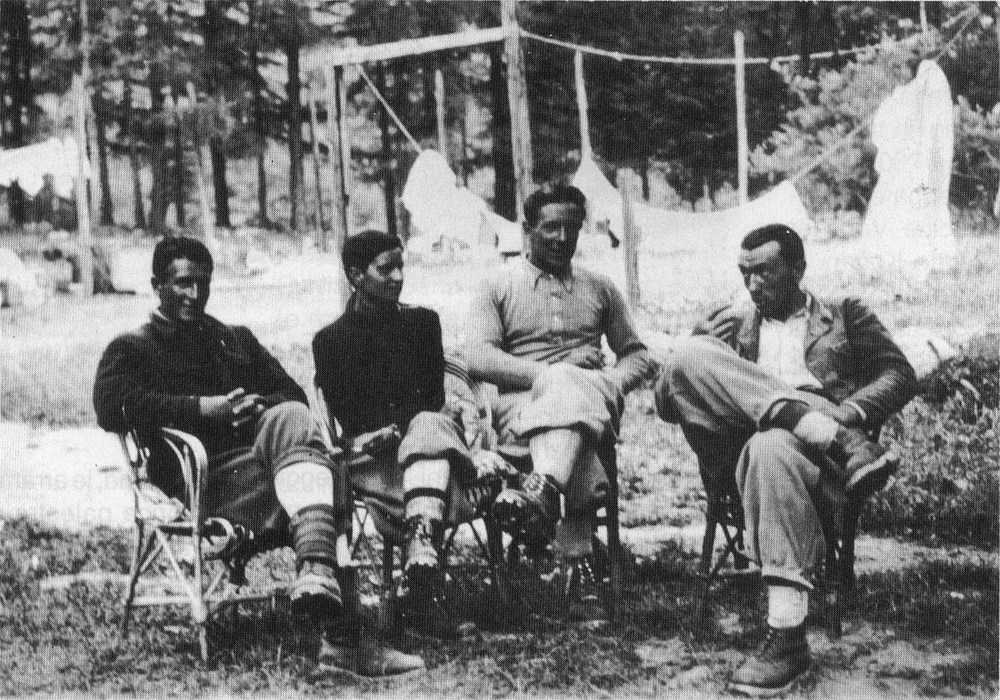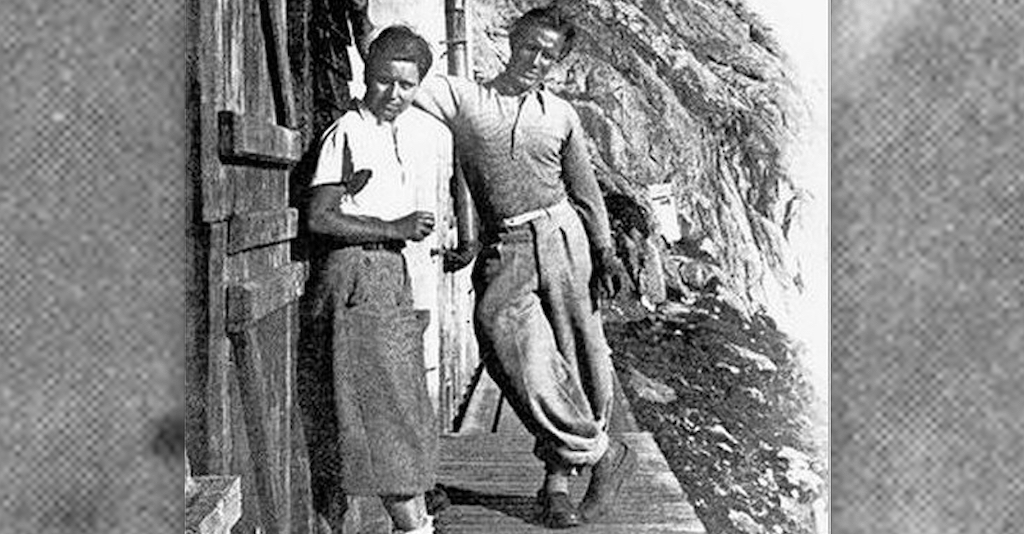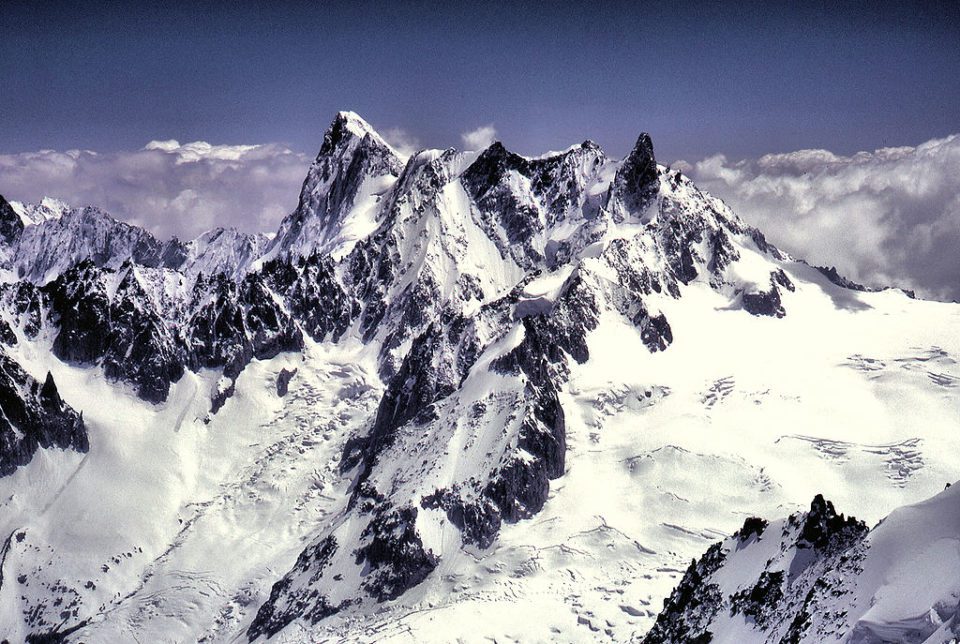Born in 1908, Louise “Loulou” Boulaz reached her prime in the golden age of Swiss mountaineering, a time and place of abundant opportunity for any man bold enough to make his mark.
Boulaz, of course, was not a man.
As a woman she was refused entry to the Swiss Alpine Club, and after her first attempt at the great North Face of the Eiger in 1937, a prominent journalist opined that to try again would be an “insult” to the mountain. She went back three more times.
Boulaz excelled at skiing from a young age, finishing fourth in slalom at the world skiing championships in Chamonix in 1937—a remarkable result, considering she held down a full-time job and had by that time been notching impressive mountaineering ascents for nearly half a decade. She would continue with the Swiss national ski team until 1941, when the Second World War put an end to meaningful international competition, but climbing was her primary sporting focus throughout her life. And it was always sport to Boulaz, according to her longtime friend Silvia Metzeltin.
The problem was not only finding a companion willing to climb with a woman, but also one capable of keeping up with her.
“Unlike her contemporaries, Loulou had little interest in the romantic dimension of mountaineering,” Metzeltin wrote in a 1992 remembrance (Italian). “She never wanted to live in the mountains, and never lost a day’s work for a climb. For her, mountaineering was basically a sport of adventure and competition, which affected her life deeply without going beyond the boundaries of free time.”
The Grandes Jorasses (left peak, 4208) and Dent du Geant (right, 4103 m), near Chamonix, France. Boulaz lost the historic race for the first ascent of the North Face of the Grandes Jorasses by two days. She made the first female ascent of both peaks. Photo: Adrian Pingstone
Fortunately, mountains were all around her home in Geneva. The limestone cliffs of Mont Salève served as a sort of meeting place and outdoor rock gym for local climbers, boasting more than 100 routes just outside of town. And on a clear day the Mont Blanc was visible from the city’s lakefront, its granite massif beckoning with the promise of longer and more complex climbs.
Boulaz was on the fringes of the climbing scene, especially in the early days. Aside from being a woman, she was uncomfortable in the company of Geneva’s well-heeled climbers. Her father was often unemployed and her mother worked in a café, having been forced to give up her job as a schoolteacher when she married. So Boulaz, whose politics evolved from youthful anarchism to a mature embrace of feminism and worker’s rights, kept to the margins and let her climbing speak for itself.
In the early years she climbed often with another pioneering female climber, Lucie “Lulu” Durand. Together Loulou and Lulu made the first all-female ascents of the Dent du Requin (1932) and the southwest face of the Dent du Geant (1933), as well as a traverse of the east summit of Les Droites (1935). “This so annoyed some male mountaineers that they sometimes refused to recognize [Boulaz and Durand’s] accomplishments, even when they followed them in person,” Metzeltin wrote.
Boulaz didn’t much care. She had her sights on even bigger prizes. By the early 1930s, the steady progression of Alpine climbing had spared only a handful of notable peaks, the so-called “last great problems” of the range: The north faces of the Eiger, Matterhorn, Grandes Jorasses, Cima Grande di Lavaredo, Petit Dru, and Piz Badile.
The race was on, and Boulaz was keen to join the field. The problem was not only finding a companion willing to climb with a woman, but also one capable of keeping up with her. She found him in Raymond Lambert, then an aspiring mountain guide five years her junior. “We were as clueless as we were ambitious,” Boulaz would write decades later in the German climbing magazine Der Bergsteiger. But they would soon make their mark.
A German team had solved the Matterhorn in 1931, but the North Face of the Grandes Jorasses continued to repel all comers. By the time Boulaz and Lambert arrived in June 1935, five successive expeditions had failed to reach the summit, with three dead in the attempts.
In an impromptu partnership with Italians Giusto Gervasutti and Renato Chabod, Boulaz and Lambert climbed two days and a night through lightning and pounding hail, only to discover a pair of German climbers had reached the summit just two days earlier. Boulaz was the first woman to make the ascent, but that was hardly remarkable. Most of her notable climbs were first female ascents, including the North Face of the Petit Dru that same summer.

Giusto Gervasutti, Loulou Boulaz, Raymond Lambert and Renato Chabod, in July, 1935, following the “race” for the North Face of the Grandes Jorasses.
Boulez would climb all of the great north faces except the Matterhorn, which didn’t interest her, and the Eiger, which she tried four times without success (1938, 1942, 1958, and 1962). In 1982, she told an interviewer, “Four times we tried the Eiger, four times we had to retreat. But, I’m still alive!”
The outbreak of the Second World War effectively closed the Mont Blanc region to climbing, and Boulaz turned her attention to the high peaks of the Valais region in southern Switzerland. In those years Boulaz climbed with Pierre Bonnant, and their relationship grew “beyond mountaineering,” according to Metzeltin’s account. After the war the duo returned to Mont Blanc’s granite spires, where Boulaz repeated the North Face of the Petit Dru and notched dozens of other notable climbs, always on weekends and holidays from her work as a stenographer at the International Labor Organization in Geneva.
Boulaz’s political leanings and gift for languages made her an ideal fit for the job, mountaineering historian Sallie Greenwood wrote in Alpinist. “The ILO supported workers’ rights and equal pay for women, ideals consistent with Loulou’s leftist and feminist leanings. Some climbing friends came to call her “Loulou la Rouge.”
The nickname reflected “not so much the almost inevitable color of her sweater as her political ideas,” Metzeltin quipped. Boulaz had wanted to pursue a career in politics, but women in Switzerland did not even have the right to vote until 1971. So she skied and climbed and lived by her principles. Invited to dinner in the grand bourgeois home of a climbing partner, Georges De Rham, she demanded the cook eat at the table with them and not alone in the kitchen.
In 1952, Boulaz and Bonnant attempted the Cassin route on the Grandes Jorasses, and were forced to spend three nights on the wall without shelter. Boulaz lost two toes in the ordeal, but Bonnant fared far worse. Both his feet were amputated almost entirely, bringing his mountaineering career to an abrupt end. The end of the relationship was perhaps inevitable, Metzeltin wrote, but the suddenness of the rupture nonetheless came as a shock, and in her despair, Boulaz destroyed her climbing journals. Thus history is left only the bare outlines of a career that, according to the great André Roch “put her without question amongst that small elite of very great alpinists of the 20th century.”
Boulaz was never one for looking back. When Greenwood visited the septuagenarian Boulaz in Geneva in 1984, she wrote, “When I asked the obligatory why, she didn’t hesitate, ‘I climbed for climbing.’ She wanted to climb hard and she did. ‘I have no photographs.’ She gestured ripping up prints. ‘Why?’ I asked, stunned. ‘I think it’s vanity—all is vanity,’ she said.

Boulaz with Raymond Lambert, 1935.
Boulaz continued to climb well into her 70s, in the Alps and farther afield. In 1959 she joined an all-female expedition to Cho Oyu (8,188 meters), the sixth-highest mountain in the world. Organized by the diminutive French swimwear designer and accomplished alpinist Claude Kogan and flush with backing from Paris Match, the team included 12 women from Britain, France, Belgium, Switzerland, and Nepal—including two teenage daughters of Tenzing Norgay.
Their goal was to claim the first 8,000-meter summit by a female climber, but Boulaz failed to acclimate. She was recovering in Namche Bazar when avalanches high on the mountain killed Kogan, Claudine van der Straten-Ponthoz, and Sherpas Ang Norbu and Chewong.
Boulaz returned to the Alpine north faces, claiming the female first ascent of Cima Grande di Lavaredo (1960) and Piz Badile (1964). She had an appetite for hard climbing well into her 50s, teaming with younger partners such as Yvette and Michel Vaucher with whom she made her final attempt at the North Face of the Eiger in 1962, turning back in bad weather after reaching the Ramp.
In 1977, at the age of 69, she took a two-month journey with Metzeltin to the Sahara, completing several new routes in the Air massif, including “a beautiful tower that we named for her: ‘Tour Loulou.’” She died in Geneva in 1991, aged 83 years.


3 comments
I don’t think the title of your article matches the content lol. Just kidding, mainly because I had some doubts after reading the article.
Thanks for sharing. I read many of your blog posts, cool, your blog is very good.
I don’t think the title of your article matches the content lol. Just kidding, mainly because I had some doubts after reading the article.